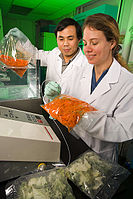
Photo from wikipedia
In this study, we prepared new antioxidant active plastic bottle caps by incorporating butylated hydroxyanisole (BHA) or butylated hydroxytoluene (BHT) and 2% (w/w) white masterbatch in high-density polyethylene (HDPE). Fourier-transform… Click to show full abstract
In this study, we prepared new antioxidant active plastic bottle caps by incorporating butylated hydroxyanisole (BHA) or butylated hydroxytoluene (BHT) and 2% (w/w) white masterbatch in high-density polyethylene (HDPE). Fourier-transform infrared (FT-IR) spectrometry revealed that the antioxidants and HDPE were uniformly mixed with noncovalent bonding. In addition, the differential scanning calorimetry (DSC) test revealed that the change in melting point and initial extrapolation temperature of the antioxidant active caps was not significant. Sensory evaluation and removal torque tests validated the suitability of the antioxidant active plastic bottle caps in industrial application. The antioxidant activity increased with a greater concentration of BHA and BHT incorporated in both antioxidant active caps (p < 0.05) and with more impact on the BHA cap compared to BHT cap in terms of antioxidant activity. Migration experiments for 10 days at 40 °C and 2 h at 70 °C showed that active antioxidants in the plastic bottle cap were more easily released into fatty foods and milk products that are highly sensitive to oxidation, and the migration of BHA and BHT did not exceed the maximum amount specified in (EC) No 1333/2008 (<200 mg/kg). As such, the antioxidant active plastic bottle caps inhibited oxidation, thereby ensuring higher food quality.
Journal Title: Materials
Year Published: 2021
Link to full text (if available)
Share on Social Media: Sign Up to like & get
recommendations!